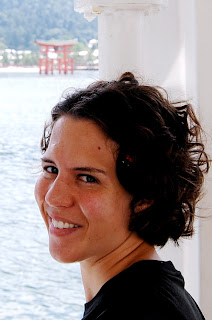Joe and me on the Great Wall of China
Of course one of the highlights of our China trip was our visit to the Great Wall.
Though the Great Wall once spanned more than 8,800 miles, it is no longer in one piece. Parts of the wall have crumbled and broken down, but certain sections are accessible to tourists. We essentially had two options to see the wall while we were in Beijing: either go to Badaling, the closest and most easily accessible section of the wall (and thus most crowded), or take a tour offered through our hostel to hike between a couple sections that were further away, but more beautiful and less crowded. Joe wanted to go to Badaling. I wanted to do the hike. Guess who won.
And thus we were up at 6 a.m. waiting for the tour van to pick us up. The itinerary: drive for three hours to the Jinshanling section. Hike for four hours to the Simatai section. Have lunch at a Chinese restaurant. Drive three hours back.
The stretch between Jinshanling and Simatai amounts to six miles, but the hike takes four hours because the wall is steep and crumbling in sections, requiring hikers to use both hands to safely navigate. All that effort came with a reward however — the mountainous terrain made for spectacular scenery.
When we went, there were numerous trees covered in apricot blossoms, which I at first mistook for cherry blossoms. If you look at the pictures above you will notice the blossoms dotting the hillsides. This picture of the blossoms was my favorite though:
One of the older, disintegrating towers:


So now I will make a confession. About an hour into the hike, at the base of a very long incline and looking at the wall snake up and down, up and down the mountains, the tour guide gave us a choice. We could either continue the hike along the wall, or we could take a shortcut down through a valley that would cut out a portion in the middle and get us to Simatai faster, leaving more time for photographs. The group split in half — half wanted to continue on the wall, and half wanted to take the shortcut. Joe wanted to do the shortcut. I stared up at the long and steep hill. My motivation for doing this trip was more about wanting to see the scenery than sweat my way through a challenging hike anyway, I reasoned. And the scenery didn't look like it would change much from what we'd already seen. I caved. We took the shortcut.
On one hand I kind of regretted that. On the other, it gave us the opportunity to see some things I hadn't expected. Living in the shadow of the Great Wall were poor farmers raising goats and crops on terraced hills.

Now that's a room with a view.

This old man's back was permanently bent into this position.

Terraced fields

(Photo by Joe)

Finished! View of the wall from the restaurant where we ate lunch. (Photo by Joe)
Parts of the trip did not go as planned... The drive there and back took four hours each way, not three (with no stops). The gas station we stopped at just before starting the hike had the most primitive bathroom I have ever used: a large concrete room with holes where you do your business out in the open — no stalls, no running water, no toilet paper, nothing — just go and let it drop down a concrete chute. A Dutch couple who came on the trip actually brought their 1-year-old child — who was sick, and who we suspect gave his cold to Joe, who later gave it to me. And from the time we started the hike, we were followed by Chinese hawkers. They sweetly offered to take our picture in spots and always offered us a hand to get over rough patches, and then literally begged us to purchase exorbitantly priced souvenirs after following us for three hours. All stuff that left a bad taste in my mouth.
But hey. We got to see the Great Wall of China. It was breathtakingly beautiful. Really can't complain. The whole time I couldn't help but think "I can't believe I'm actually on the GREAT WALL OF CHINA!" Surreal, right! What an amazing blessing.
Here's a slideshow of some more photos, for those who are interested:











 From Beijing, Joe and I took an overnight train to Xi'an, home to the famous Terracotta Warriors. Hate to say it, but Xi'an was probably the low point of our trip. While we enjoyed some of the sights there, worries about safety definitely put a damper on our stay.
From Beijing, Joe and I took an overnight train to Xi'an, home to the famous Terracotta Warriors. Hate to say it, but Xi'an was probably the low point of our trip. While we enjoyed some of the sights there, worries about safety definitely put a damper on our stay.




